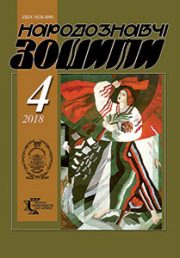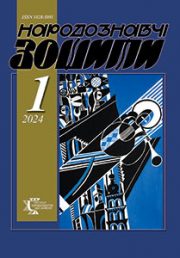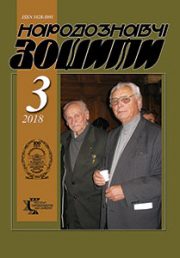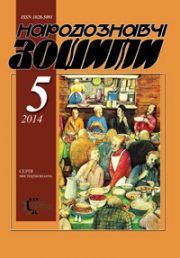The Ethnology Notebooks. 2019, № 6 (150), 1684—1691
UDK75/76.071.1(477.83-25)”193/198″З.Флінта
DOI https://doi.org/10.15407/nz2019.06.1684
ALLEGORICAL WORKS OF ZENOVIJ FLINTA AND THEIR INTERPRETATION
MATKOVSKA Ivanna
ORCID ID: https://orcid.org/0000-0001-7941-051X
Graduate student of Lviv
National Academy of Arts
Kubiiovycha Street 38, 79011, Lviv, Ukraine
Contacts: e-mail: ivanna_novakivska@ukr.net
Abstract. Introduction. Zenovij Flinta is one of the key figures in Ukrainian art of the 1960s—80s, who despite the dominance of socialist realism in the contemporary official art, created using allegories in an original authorial manner embodied complex of philosophical images in the late 1960s—1980s in Lviv.
Problem statement. None of the authors who described specific activities of Flinta or pages from his biography, resorted to the analysis of the philosophical essence of allegory in the works of Z. Flinta and their explanations. In the Soviet art criticism his works were brought under the requirements of the Communist system and were treated as socialist realism.
Purpose of this research is analysis of the philosophical essence of Zenovij Flinta’s allegorical works — genre works, still lifes, landscapes, created by him in an original authorial manner in the late 1960s—1980s in Lviv. Complex of philosophical images, is actual problem of ukrainian art history.
Results. After analyzing a number of allegorical works of the author, we believe that Zenovij Flinta in his paintings with the help of allegories opens his own world and his philosophy of existence, comprehends himself, conveys to the viewer the true human values as constants of his own Universe, embodied on the canvas.
Conclusion. In the late 1960s, Z. Flinta created his own artistic means for expressing the idea of a work in allegorical images — in composition he emphasized allegories, objects or figures that reveal the philosophical meaning of the work. The color in his works is also an expression of allegorical meanings — the artist uses muted colors from olive green and ocher to brown and gray-blue and deep azure tones, which, by contrasts or gradations, give for ordinary objects a new, different meaning.
In our opinion, recomprehension of the works of Zenovij Flinta, first of all, ofthe allegorical narrative works, of still lifes and landscapes of the endof the 1960—1980-ies with detailed analysis of their philosophical content will give the opportunity to reproduce a real, and not distorted by Soviet historiography, picture of Creativity of Z. Flinta, the value of which hasto be properly evaluated in the Lviv art of the 1960—80-es, and Ukrainian culture, in general. We are sure that in spite ofthe totalitarian regime, in spite of many prohibitions, his works, because of their unusual philosophical content, aesthetic and artistic value, influenced the artistic processes in Lviv and further development of Ukrainian art.
Keywords: Zenovij Flinta, Lviv art of 1960s—1980s, Zenovij Flinta’s allegorical works, story works, still lifes, landscapes of the late 1960s—1980s.
Received 28.11.2019
REFERENCES
Pelens’ka, O. (Ed.). (1985). Zenovij Flinta. Painting. Graphics. Ceramics: catalog. Lviv [in Ukrainian].
Ostrovs’kyj, G. (1980). Compaction of time. Zhowten, 12, 142. Lviv [in Ukrainian].
Ostrovs’kyj, G. (1983). Involvement of the viewer. Ukraina, 20, 12. Kyiv [in Ukrainian].
Ostrovs’kyj, G. (Ed.). (1981). Lyubomyr Medvid, Oleg Min’ko, Zenovij Flinta: catalog. Lviv [in Ukrainian].
Ostrovs’kyj, G. (Ed.). (1986). Lyubomyr Medvid, Oleg Min’ko, Zenovij Flinta: catalog. Moscov [in Russian].
Golubec, O. (1991).Lviv ceramics. Kyiv [in Ukrainian].
Shymchuk, Je. (Ed.). (1995). Zenovij Flinta: album. Lviv [in Ukrainian].
Zhyrko-Kozynkewych, O. (Ed.). (1992). Lyubomyr Medvid, Oleg Min’ko, Zenovij Flinta: album.Kyiv [in Ukrainian].
Danyliv-Flinta, I., & Maik, N. (Eds.). (2005). Zenovij Flinta. 1935—1988: catalog. Lviv [in Ukrainian].
Danyliv-Flinta, I., & Kosmolinska, N. (Eds.). (2010). Zenovij Flinta: catalog. Lviv [in Ukrainian].
Zvirynska-Chaban, Kh. (Ed.). (2017). Zvirynskyj Karlo. All my paintingis — to prayer. Memories, interviews, reflections, articles. Lviv [in Ukrainian].
Ripko O. (1996). In search of a lost past. Retrospective of Lviv artistic culture of ХХ century. Lviv [in Ukrainian].
Medvid, L. (2006). Zenovij Flinta and westukrainian Fine Art school 1960—80-s. Fine Arts (Obrazorvorche mystectvo), 2, 68—73.Kyiv [in Ukrainian].
Yaciv, R. (2006). Ukrainian art of ХХ century: ideas, phenomena, personalities: collection of articles. Lviv [in Ukrainian].
Yaciv, R. (2008). Lviv Fine Art 1960—1970-s: in search of the key of understanding. Ukraine Art Map (Mystecka mapa Ukrainy) (Pp. 27—29). Kyiv [in Ukrainian].
Golubec,O. (2008). The Lviv artistic environment of the first half of ХХ — beginning of ХХІ century: uniqueness factors. Ukraine Art Map (Mystecka mapa Ukrainy) (Pp. 24—26). Kyiv [in Ukrainian].
Golubec, O. (2012). Art of ХХ century: Ukrainian way. Lviv [in Ukrainian].







